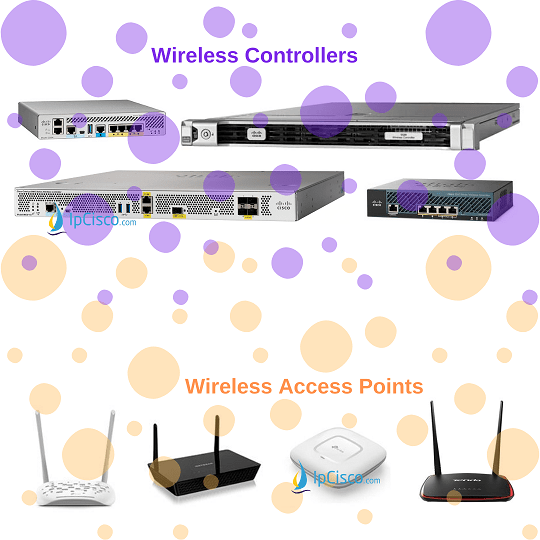- COURSES
- SPECIALS
- BLOG
- MEMBERS
- SHOP
- ABOUT
- ENROLL HERE

In Cisco, there are two types of Wireless Solutions. One of them is using only Autonomous Access Points and the other is using Light Weight Access Points (LWAP) with Wireless LAN Controllers. So, What are Access Points? What is a WLC? Let’s learn each of these devices in Wireless Networks.
Table of Contents
Access Points are one of the important devices in a WLAN. So, what is an Access Pioint? An Access Point (AP) is a the device that receives the signals from WLC and deploys this signals to the hosts according to a coverage area.
There are two types of Access Points. These are:
Autonomous Access Points (AP) are independant devices. They do not need WLC. These APS can be managed centrally also by Cisco Works Wireless LAN Solution Engine (WLSE). With Autonomous Access Points (AP), SSID and VLAN must be statically configured in all the access point for roaming.
Lightweight Access Points (LWAP) are used together with Wireless LAN Controllers (WLCs). In this architecture Lightweight Access Points is responsible for real time processes. The roles of WLC are more: Authentication, Security, QoS, Mobilliy Mangement, Forwarding etc.
User traffic between AP and WLC is tunneled with different protocols. The protocols used between WLC and LWAP are:
Both of these protocols work with UDP.
Wireless LAN Controller can be or can not be in the same ip subnet with Lightweight Access Point. The only important thing is they can reach together over IP.
Wireless LAN Controller (WLC) is a central device with which you can do configurations, you can manage your operations etc. in a wireless network. With this capabilities, WLCs reduces deployment, operations and management cost in a wireless network.
There are two types of APs. These are:
Lightweight Access Points (LAPs) can be managed with Wireless LAN Controllers (WLC). A WLC can manage 6 to 300 Access Points accourding to its capacity.
SSID, VLAN etc. configurations are done on WLCs.
WLC and the LAN switch has a link between them. This link can be one link or a Link Aggregation can be used on it.
There are common standards or protocols of wireless networks. Cisco Wireless Controllers support 802.11a/n/ac and 802.11b/g/n protocols.
According to the need, wireless network sizes change. For different size wireless networks, we can use different types of Wireless Controllers.
There are three important terms about WLC. These are:
Ports are the physical connection parts from WLC to any device.
Interfaces are the logical connection mapping to a VLAN.
There are different types of Wireless LAN Controllers in Cisco. Some of these Cisco WLC Models are retired and not supported any more. Some of them are neww technology. Here, we will talk about a new WLC Series. They are Cisco Catalyst 9800 Series Wireless Controllers.
Cisco Catalyst 9800 Series Wireless Controllers more reliable and more secure WLCs. They use IOS-XE as an operatins system. Ther are different WLC models in this series for different needs. These Models are given below:
Beside, there are embedded versions that are for Access Points and Switches:
Now, let’s telk about these WLC Models detailly.
Leave a Reply